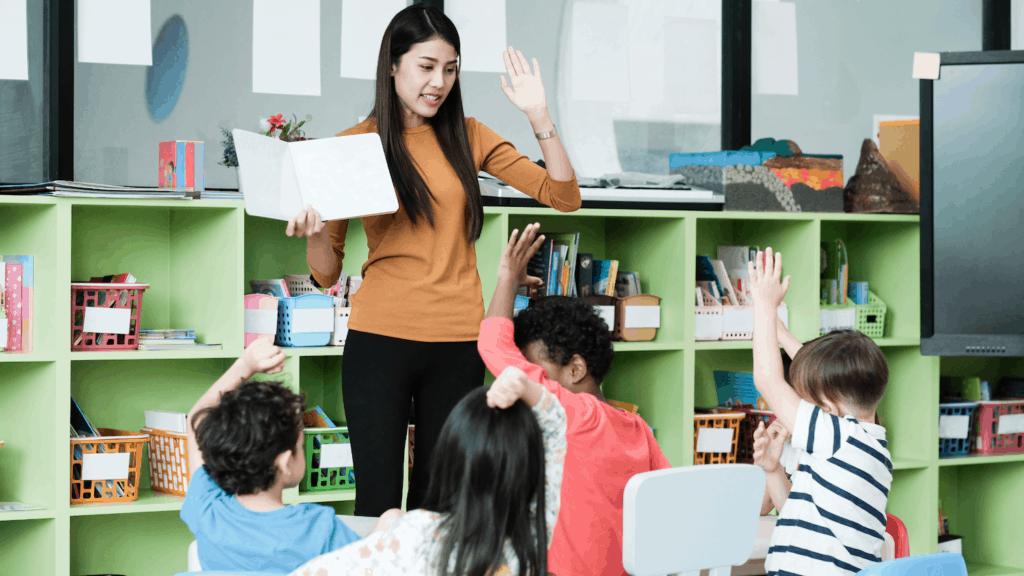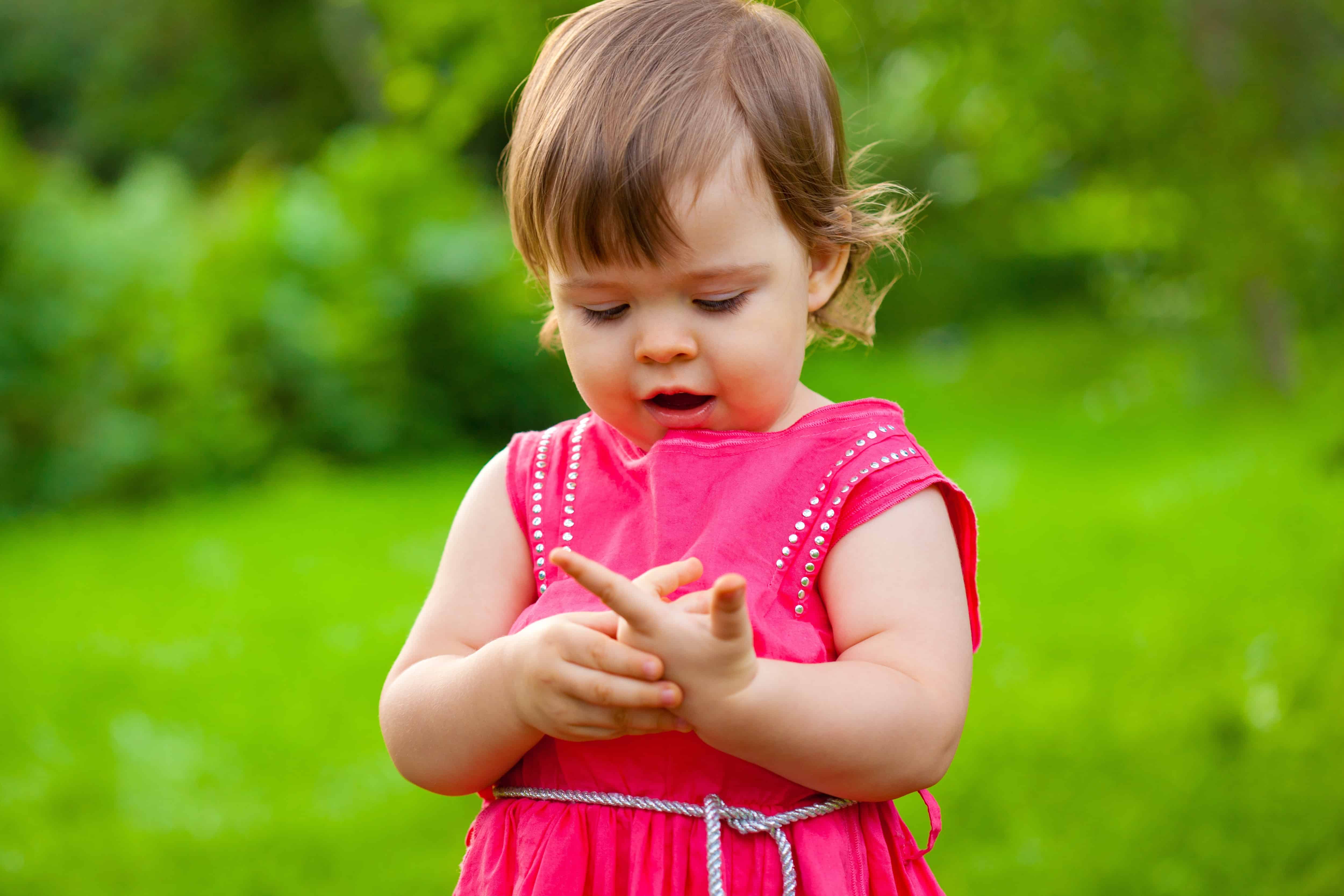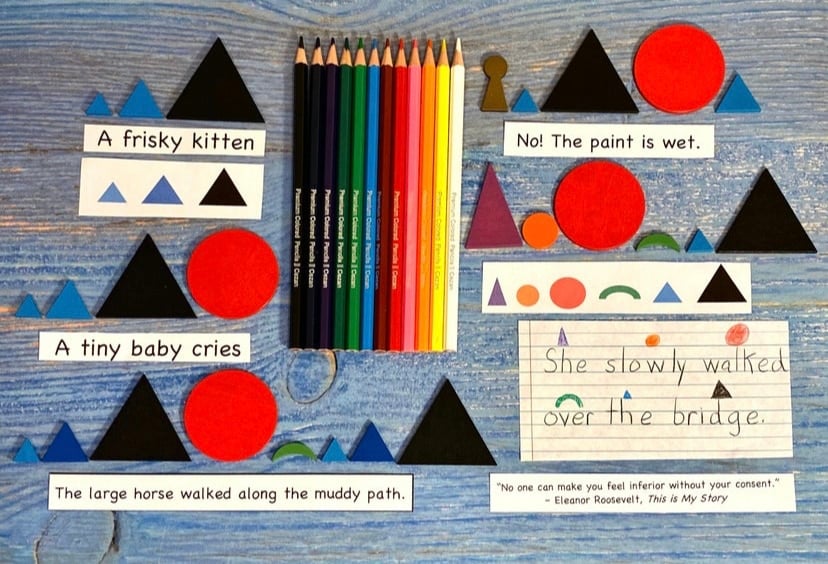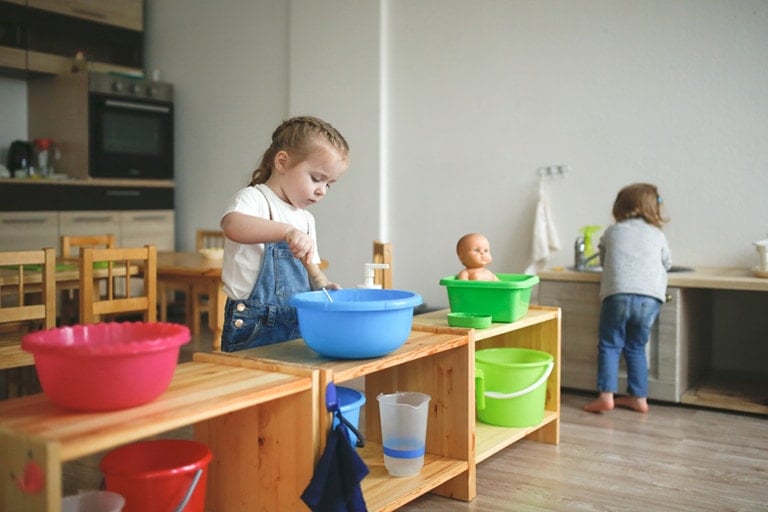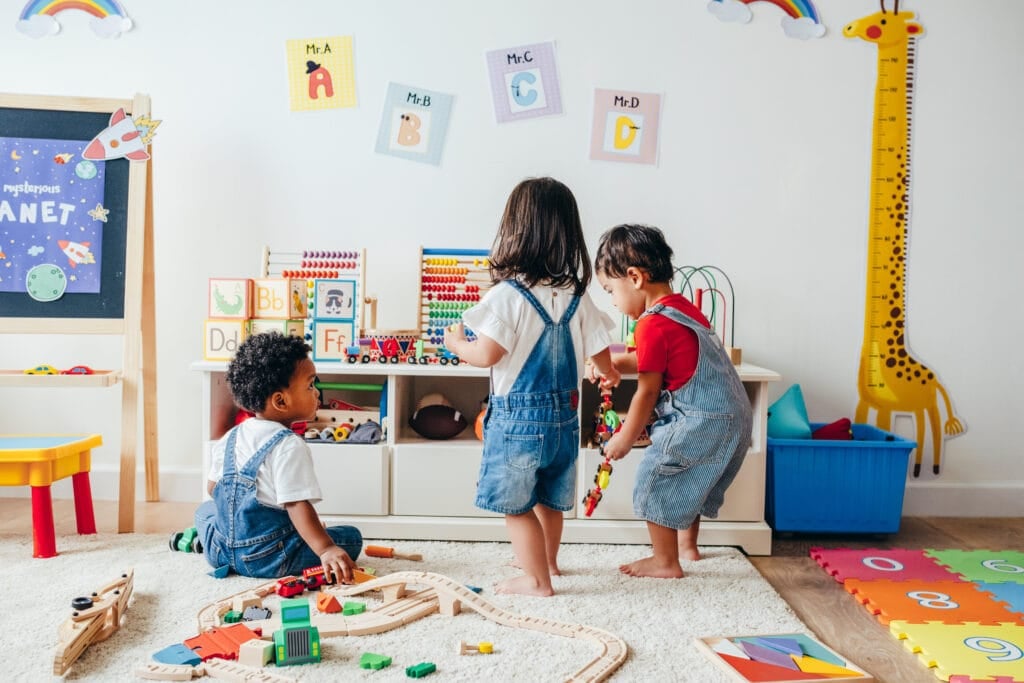Montessori preschoolers become more active and ready to take on more complex activities. They are provided with various activities in arts and crafts, reading and writing, sensorial learning, Mathematics, science, practical life skills, and other hands-on activities as they prepare for the smooth transition to kindergarten.
The
The activities foster the child’s sensorimotor, intellectual, physical, social, emotional, and brain development. The Montessori curriculum offers a new dimension to early childhood development. Preschoolers develop a strong sense of responsibility, self-discipline, leadership, independence, and a lifetime love for learning. Read on to learn more about the preschool curriculum.
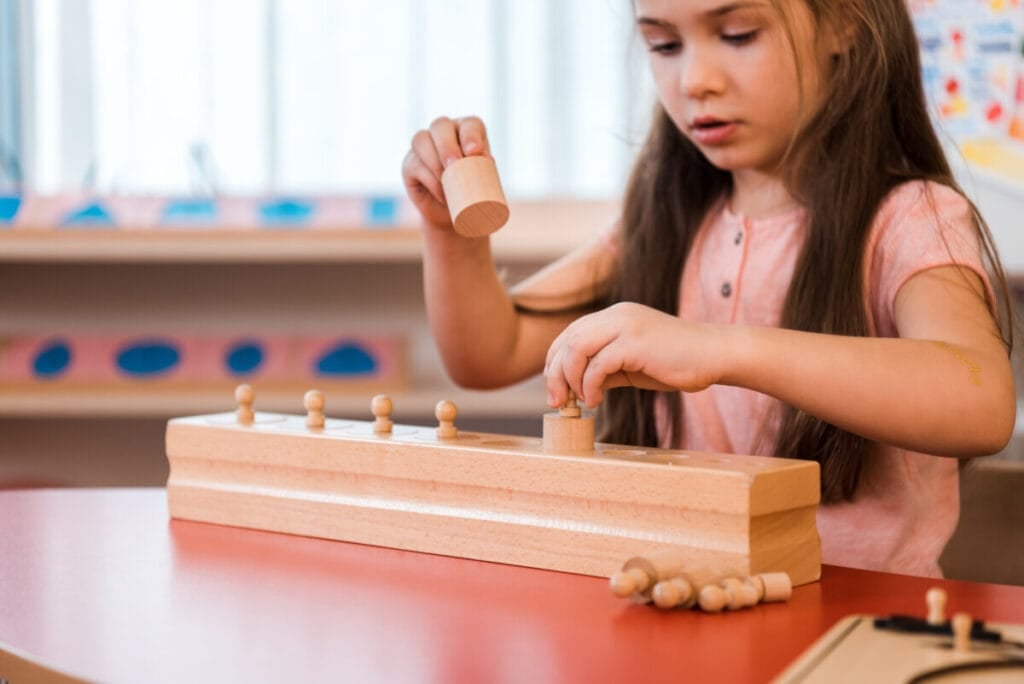
What is the Role of Play in the Montessori Curriculum?
Play is the work of the child. Play-based learning is nurtured in the
Play is vital for the successful completion of the Montessori curriculum areas.
Now let us explore the different domains of independent play for preschoolers in a
Practical Life Exercises
Montessori practical exercises prepare preschoolers for the transition into school. The following practical life exercises are introduced to preschoolers to learn how to take care of themselves, control their environment, and develop fine and gross motor skills in preparation for writing.
- Opening and closing activities teach children how to open and close assorted bottles, boxes, locks and keys, nuts and bolts. The activities strengthen the child’s pincer grip in preparation for writing and other academic activities.
- Pouring water through a funnel into marked containers offers the child a more complex pouring activity because the child learns to pour and stop at the graded line without spilling the water. The activity indirectly introduces the measurement and estimated quantity.
- Transferring activities; transferring water from one container to another with a pipette or turkey baster and transferring objects with tongs and tweezers offer more challenging tasks for the preschoolers. It builds their muscles for pincer grip.
- Cutting activities: preschoolers have fun cutting cards with different paper lengths and shaped lines, cutting round outlines of templates of animals and patterns with scissors. Cutting activity promotes concentration and a solid pincer grip.
- Use of a knife: preschoolers learn how to hold and slice with a knife. Play knife is first introduced for cutting soft food like bananas and apples. When the child shows evidence of progress, then introduce a real knife.
- Folding small table mats along embroidered lines: This activity aims to teach how to fold a square or triangle and to give the mathematical experience of discerning a half and a quarter. It also prepares the child for school projects.
- Exercises for the care of the self: exercises such as changing shoes, dressing frames (shoelaces, bow tying, buckling), polishing shoes, folding clothes, and caring for the nails and hair develop the child’s personality and self-esteem.
- Exercises for the care of the environment: activities like sweeping, scrubbing, laying the table, and arranging flowers help children maintain and control their environment.
- Classroom skills: sharpening pencils, keeping work folders, and tracing are introduced to preschoolers to prepare them for school activities.
- Cooking skills: preschoolers are taught how to get bake simple snacks. That introduces them to the concept of weighing, measuring, sieving, whisking and mixing, rolling, and cutting pastry.
- Exercises for the development of social skills, grace, and courtesy: Children are taught good manners and social-emotional intelligence with activities like greeting people, coping with an offence, table manners, and the use of eating utensils. Children learn to say ‘excuse me, thank you, I am sorry, please wait for your turn.
Preschoolers’ Practical Life activities develop strong muscles in preparation for school activities. The activities also develop the child’s eye-hand coordination, fine motor skills, concentration, and independent play.
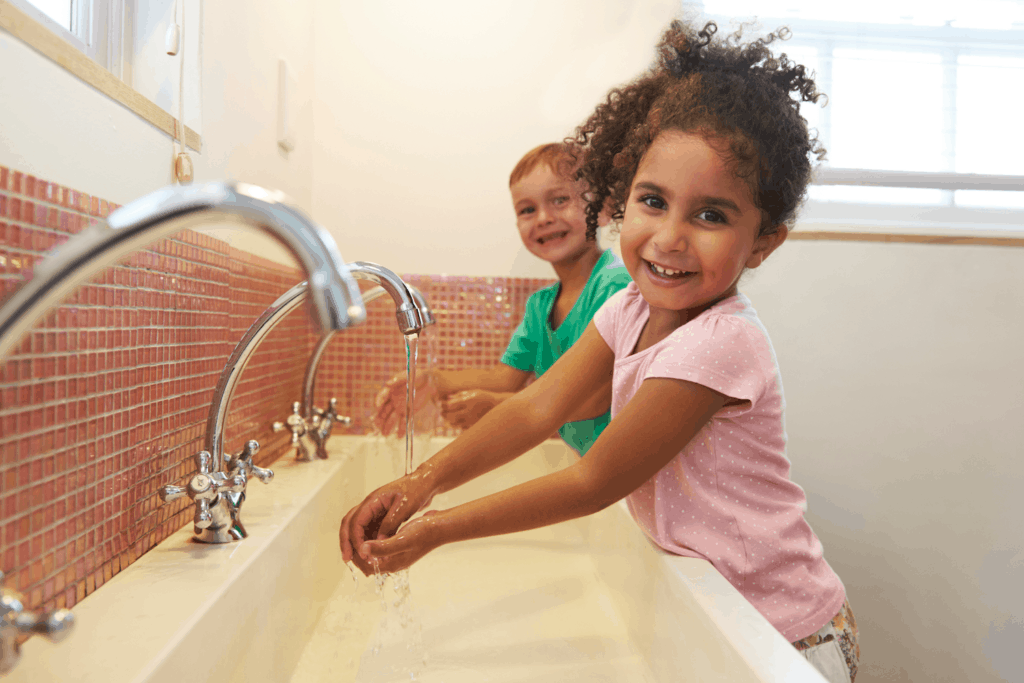
Sensorial Education
Preschools explore and experience the prepared environment with all their senses. Sensorial materials used in the
The following sensory learning activities are introduced to preschoolers to help them attain maximum refinement of their senses.
Color box 3: the material is divided into nine sections containing seven shades of nine different colors; blue, red, yellow, orange, green, purple, pink, brown, and grey to teach the child how to grade the color tablets from the darkest to the lightest shade. This activity refine the child’s visual perception of color. Check out our full article on color boxes.
Constructive triangles: provide the child the opportunity to experiment with various geometric shapes like triangles, squares, and hexagons, and discover how these various shapes can be combined to form other shapes. The activity prepares preschoolers for later geometry study by giving the child visual and muscular perception of shapes.
Geometric solids: provide the child with the experience of solid shapes like cubes, spheres, cylinders, and pyramids in the environment and stimulate interest in discerning these shapes.
Touch boards and fabrics; stimulate the child’s interest in textures within the environment by providing sensory experiences.
Mystery bags; help the child recognize regular solid shapes and other familiar objects with the stereognostic sense. For these activities, children are blindfolded to isolate their other senses. They dip their hand inside the mystery bag, feel it and say the object’s name.
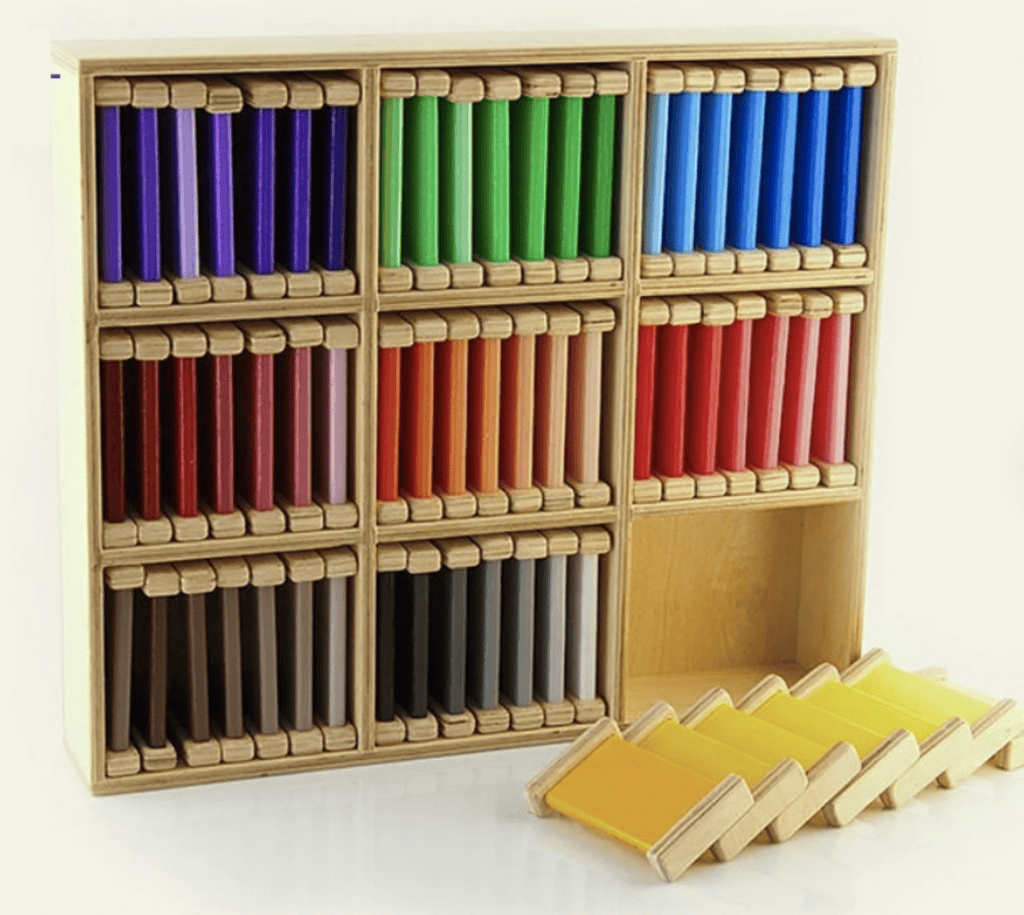
Language
The Montessori language curriculum is excellent for developing communication and literacy skills. Some of the language activities for preschoolers include:
- Stories and poems: Children love to hear or read stories. It sets the foundation for pre-literacy skills using accurate vocabulary and conversation with peers and adults. Books feed the child’s imagination, increase knowledge, and improve their language awareness.
- I spy games; children learn to listen to the initial sounds of objects and pick out the appropriate object. The teacher lays out objects and names them. She then invites the child to listen and pick the object with the initial sound. For instance, the teacher lays out a carrot, tomato, and apple and says,’ I spy an object with the letter sound ‘t’; the child listens and picks out the tomato.
- Pink, blue, and green language series: introduce the child to graded phonics instruction. Children learn how sounds are combined to form words, phrases, and sentences using sandpaper letters, large movable alphabets, objects, pictures, and cards.
- Grammar Boxes: introduce the children to parts of speech, singular and plural, with cards and objects for children to see the difference between singular and plural quantities.

Mathematics
Maria
- Cards and counters: provide further practice in counting and associating the correct numbers of objects with the numerals or written symbols.
- Short bead stair: children first learn how to arrange the bead in sequential order from 1 to 10, forming a triangle. Then, the child learn how to add and subtract with the material.
- Sequin boards A and B: Sequin board A teaches children quantities and symbols, from 1 to 19. Sequin Board B teaches children quantities and numerals 10 to 90, 20 to 99
- Small number rods: introduce the child to the addition and subtraction of numbers 1 to 10 and how to record the answers.
- The Golden bead material is an excellent material for teaching preschoolers how to calculate numbers up to 9000. It is also used for addition, subtraction, multiplication, and division of numbers.

Cultural Subjects
The Cultural Curriculum integrates subjects, including Geography, Biology, Science, and History. Through exploring cultural subjects, children understand their culture and social responsibilities. Some of the activities include;
Classification of living and nonliving things: Children are provided the opportunity to classify picture cards or objects into living and nonliving things.
Life cycle: children use multilayer puzzles to learn the life cycle of plants and animals.
Care of the pets and garden: Children are encouraged to care for plants and animals.
Science Experiments: children are offered the appointment to conduct simple experiments, e.g., floating and sinking objects, air-water, and land, making rainbows.
Continents globe and puzzle map of the world; introduce preschoolers to different countries and continents.
Nature walk: allows children to explore and observe their immediate environment. They can collect objects like stones, feathers, earthworms, pebbles, and leaves from nature and display them on the nature table.
Music and Dance:
Children love to listen to and dance to music. Check out our full article on music and movement in Montessori preschools for more information.
Arts and Crafts:
Preschoolers are highly imaginative and creative. They are provided art materials like pom, art sticks, paints, paint brushes, and other art and craft supplies to inspire creativity. They are also provided various open-ended and enrichment materials to create whatever comes to mind.

How is Independent Play Encouraged in a Montessori Classroom?
Preschoolers in the
The
In conclusion,


